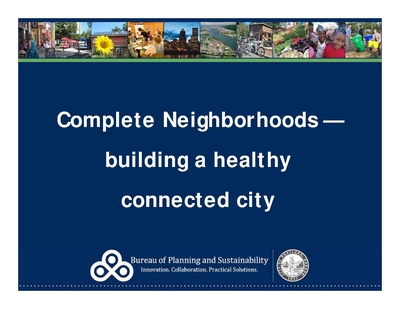Complete Neighborhoods — Building a Healthy Connected City
| Complete Neighborhoods — Building a Healthy Connected City | |
 Jamison Square Portland | |
| Team Organizations | City of Portland C40 |
| Point of Contact | Josh Alpert |
| Participating Municipalities | Portland OR |
| Sectors | Wellbeing |
| Initiative | |
| Status | Implemented |
| Last Updated | December 18, 2025 |
Summary
The goal of the Healthy Connected Neighbourhood Strategy is to bring complete neighbourhoods to 80% of the city’s population by 2035. The Strategy is integrated into the main Portland Plan, a comprehensive strategic plan to achieve urban equity and sustainability.
- What is it?
Over the last 30 years, Portland has experienced substantial growth. It grew from more than 200,000 residents, to 600,000 residents, and annexed adjacent land that did not have the same quality of infrastructure as pre-existing areas. The population growth resulted in a more diverse population; however, some of these communities did not have as much equitable access to amenities and economic opportunities.
In addition to projected population growth, Portland is challenged by its historic development pattern. Inner neighbourhoods developed in an era of streetcars and are relatively compact; however, large parts of the city developed as automobiles were becoming common and are less well-suited for pedestrians. As a result, transportation is responsible for 40% of Portland’s greenhouse gas emissions. Portland is making steady progress in reducing vehicle miles travelled and shifting to active transportation modes, but neighbourhood patterns are slow to change and require decades of careful planning and investment. The Healthy Connected Neighbourhood Strategy is designed to accelerate the shift to active transportation modes, simultaneously revitalizing neighbourhoods and realising the health, affordability, and liveability benefits of transit, walking, and cycling.
The goal of the Healthy Connected Neighbourhood Strategy is to bring complete neighbourhoods to 80% of the city’s population by 2035. The strategy is a key part of the Portland Plan, an integrated strategic plan to achieve urban equity and sustainability. Together with two other strategic priorities, and the equity framework of the Portland Plan, the Healthy Connected Neighbourhood initiative is intended to achieve 12 measures of success. These include:
- Reducing carbon emissions to 50% below 1990 levels by 2035.
- Achieving 70% mode split for transit, walking and bicycling by 2035.
- Covering 33% of the city in tree canopy by 2035.
- Additional benefits include increasing the safety, convenience and overall health of citizens, which comes from having amenities such as schools, parks, and grocery stores within walking and cycling distances.
- How does it work?
In order to achieve the measures of success, the Healthy Connected Neighbourhoods Strategy focuses on three goals:
- Ensure public decisions benefit human and environmental health
- Create a network of:
- Strong, diverse, well designed and connected neighbourhood hubs and
- City Green Ways that weave nature into the city and connect people, water, wildlife and neighbourhoods
To accomplish these goals, the city created the ‘20-minutes Neighbourhood Analysis’ to assess the ‘completeness’ of neighbourhoods, and analyse the walkability and access to services across the city. The analysis considers both the proximity to local amenities, parks, schools, etc., and the ability to access these destinations in terms of street connectivity, sidewalks, transit service and topography. This information serves to evaluate progress towards the Healthy Connected Neighbourhood goals and diagnose specific investment needs in different areas of the city.
The Portland Plan is designed to prioritise and align city budget decisions rather than require new funding. The plan provides the City of Portland with a coordinated and measurable approach in organising and prioritising city budget requests and helps prioritise work with other agencies and organisations.
When fully implemented, the new budget approach will direct City of Portland bureaus and offices to (1) identify how programs and projects support the Portland Plan strategies and specific actions, (2) use an asset management approach to achieve more equitable service levels across communities and geographies, (3) track and report on service levels and investments by community and geography, including expanding the budget mapping process, and (4) coordinate City budgets with local, state and federal agencies. Each fiscal year, the partners will review the actions and determine which actions are the highest priorities.
- CO2 reduction
As of 2012, Portland’s carbon emissions have decreased to 11.5% below 1990 levels, despite 27% population growth.
- Application
The application of the Healthy Connected Neighbourhood Strategy has resulted in the tree canopy level increasing from 27.3% to 29.9% since 2000. In terms of the goal of achieving 70% mode split for transit, walking and bicycling by 2035, 27% of trips are currently taken by these modes. As of 2014, Portland saves more than $1 billion annually as a result of driving less than other American cities. Furthermore, citizen participation is a key component of the Healthy Connected Neighbourhood strategy. From individuals and community groups to schools and businesses, Portlanders all contributed to the development of the project with more than 20,000 comments and ideas for the plan.
- Bureau of Planning and Sustainability Presentation
